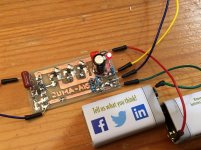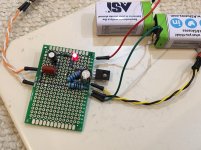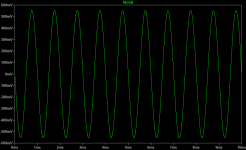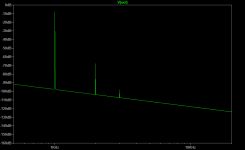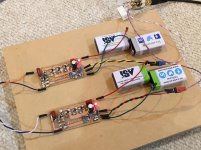Yes X, if you sub a 2SA1837 you could ramp it to 200mA with adequate heatsinking and you can even replace the bipolar with a pmos rated up to 5A.
When you design for cans you can easily indulge Class A in single end topology.
Of course you have two cap couplers but these days caps are so good that the improvements in simplicity, economy, reliability and Class A sonics can all be combined with moderate energy use.
HD
When you design for cans you can easily indulge Class A in single end topology.
Of course you have two cap couplers but these days caps are so good that the improvements in simplicity, economy, reliability and Class A sonics can all be combined with moderate energy use.
HD
Last edited:
Juma-Aksa BF862 Amp Works!
I managed to find three JFETs with Idss = 14.4/14.5/14.8 mA and used them for the three outputs and a JFET with 13.8mA on the input stage. I am using a 47R source resistor for the input and this gives me about 8.2v at the drain of Q1. Bias current in the input stage is 7.5mA as measured across the 270R resistor. The overall bias on the output is 37mA or about 12mA ea as measured across the 1W 220R source resistor. My cellphone doesn't have quite enough oomph to power my DT880-250's to loud levels. However, connecting it to my DAC, it can get loud. I am using 560nF 100V Panasonic MKT input cap, 47uF 63v Panasonic EB output cap bypassed with 1uF 63v film cap. I have 270R load resistor parallel to my phones and did not notice a reduction in amplitude when that was connected or disconnected. Leaving it in to drain that cap to reduce turn on thump when plugging phones in.
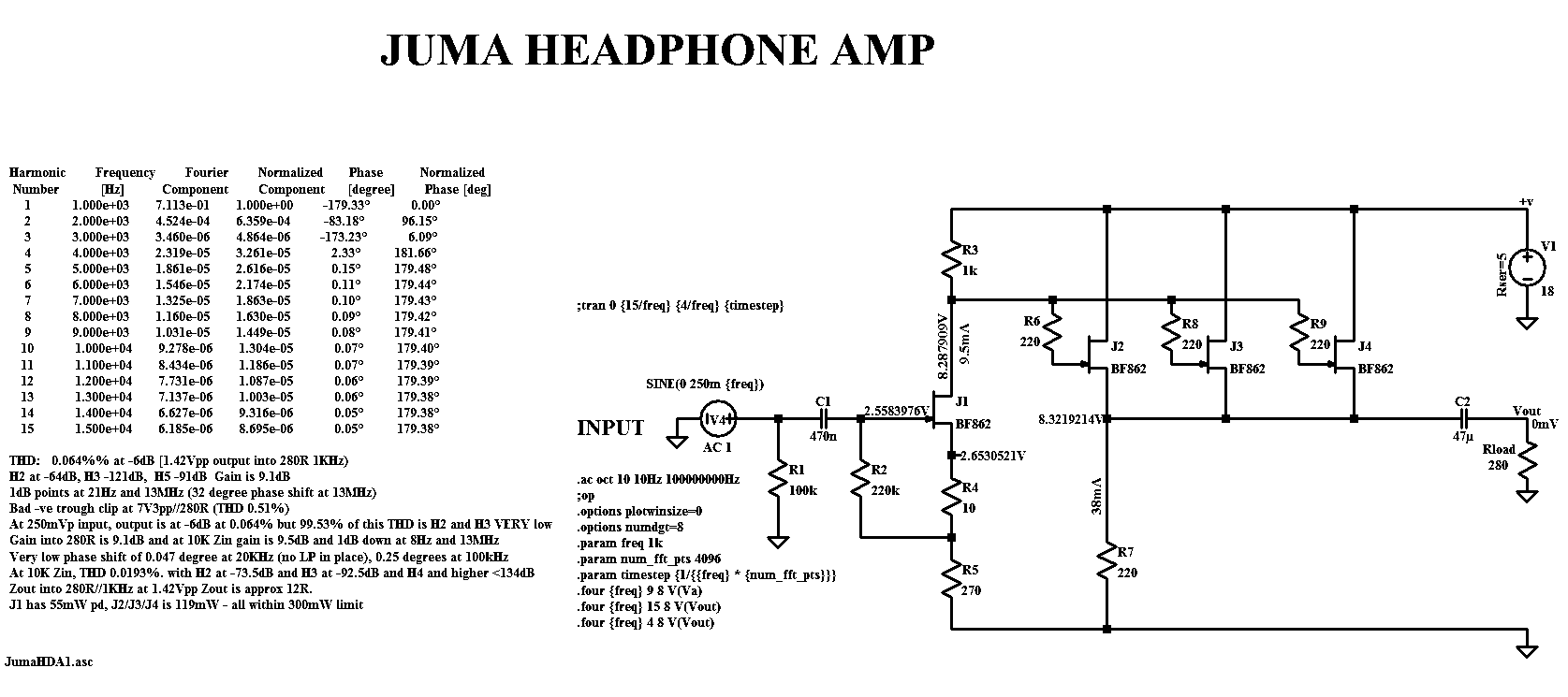
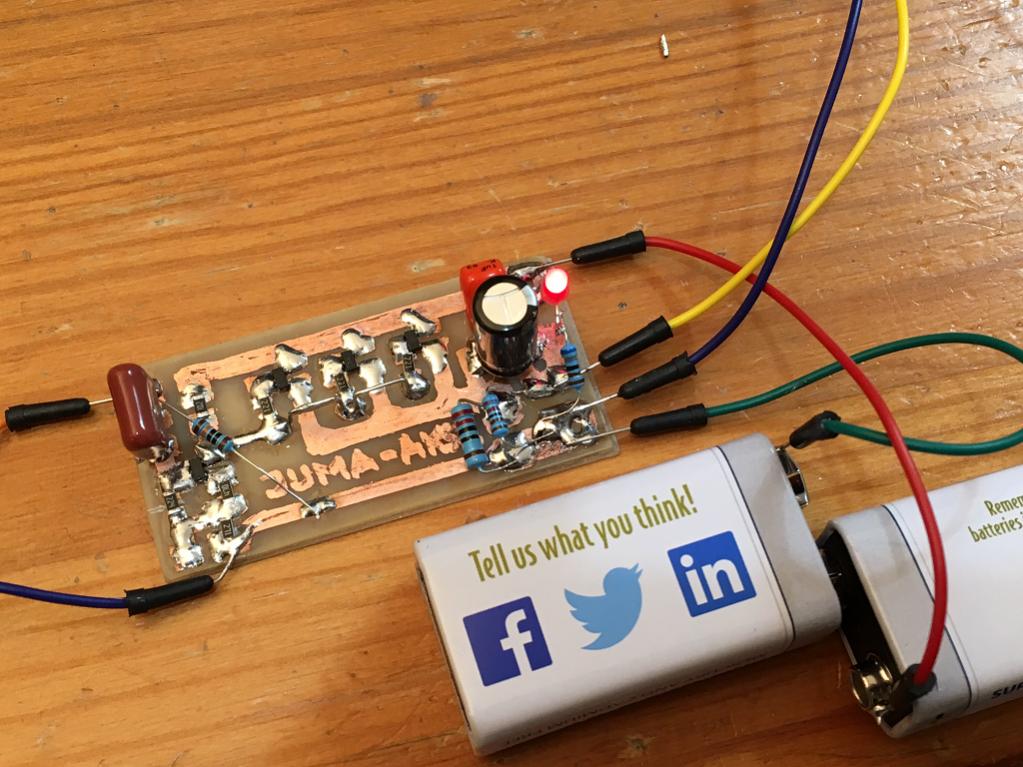
Sound impressions: quite nice, very good bass, clear mids, nice detailed highs. The bass is not as deep as my big amp, title of this thread - but then again, that amp has a 100w toroidal trafo and uses big IRFP240 MOSFET and LU1014D JFETs. However, it feels like the mids, are not as rich - not sure if that is simply because listening in mono. Hard to really tell in mono, but I can't hear any distortion. I will have to listen in comparison to my other amp to give more comparative data. For now, just reporting that it works and sounds pretty good for such a simple circuit.
I can see how this might be a slick portable CMOY type amp in an Altoids mints tin. It will need more gain to be driven from a cellphone though. I just noticed there is no global feedback on this amp.
For now, it is playing in one of my ears and I am trying different tracks that I know. It's doing a decent job on deep bass House music, jazz vocals, pop, rock...
I managed to find three JFETs with Idss = 14.4/14.5/14.8 mA and used them for the three outputs and a JFET with 13.8mA on the input stage. I am using a 47R source resistor for the input and this gives me about 8.2v at the drain of Q1. Bias current in the input stage is 7.5mA as measured across the 270R resistor. The overall bias on the output is 37mA or about 12mA ea as measured across the 1W 220R source resistor. My cellphone doesn't have quite enough oomph to power my DT880-250's to loud levels. However, connecting it to my DAC, it can get loud. I am using 560nF 100V Panasonic MKT input cap, 47uF 63v Panasonic EB output cap bypassed with 1uF 63v film cap. I have 270R load resistor parallel to my phones and did not notice a reduction in amplitude when that was connected or disconnected. Leaving it in to drain that cap to reduce turn on thump when plugging phones in.


Sound impressions: quite nice, very good bass, clear mids, nice detailed highs. The bass is not as deep as my big amp, title of this thread - but then again, that amp has a 100w toroidal trafo and uses big IRFP240 MOSFET and LU1014D JFETs. However, it feels like the mids, are not as rich - not sure if that is simply because listening in mono. Hard to really tell in mono, but I can't hear any distortion. I will have to listen in comparison to my other amp to give more comparative data. For now, just reporting that it works and sounds pretty good for such a simple circuit.
I can see how this might be a slick portable CMOY type amp in an Altoids mints tin. It will need more gain to be driven from a cellphone though. I just noticed there is no global feedback on this amp.
For now, it is playing in one of my ears and I am trying different tracks that I know. It's doing a decent job on deep bass House music, jazz vocals, pop, rock...
Attachments
Last edited:
X,
Very nice work. This is a very good HPA, and your views of the bass are interesting; the richness of the bass reflects the additional H2 of the power amp, which is also SE in topology. Looks like I was not correct; that power amp does have its benefits.....
If you want a little more bass drive, you need to move to the five or six jfet output stage, OR increase the sense of scale with the CFP I presented.
Hugh
Very nice work. This is a very good HPA, and your views of the bass are interesting; the richness of the bass reflects the additional H2 of the power amp, which is also SE in topology. Looks like I was not correct; that power amp does have its benefits.....
If you want a little more bass drive, you need to move to the five or six jfet output stage, OR increase the sense of scale with the CFP I presented.
Hugh
BF862/BD140 SE Amp
I quickly threw this together on veroboard. I even left room for a second channel on a single 6cm x 8cm board. It sounds really nice and clear with impactful bass, but volume is very low (by maybe 10x) even at full volume on my DAC. So not sure what is wrong. Maybe I have an incorrect resistor somewhere off by 10x? I am using 15k instead of 12k, and 100uF instead of 47uF for C3, but that is the only one that is off spec. I am measuring 28.2mA across the 100R source resistor.
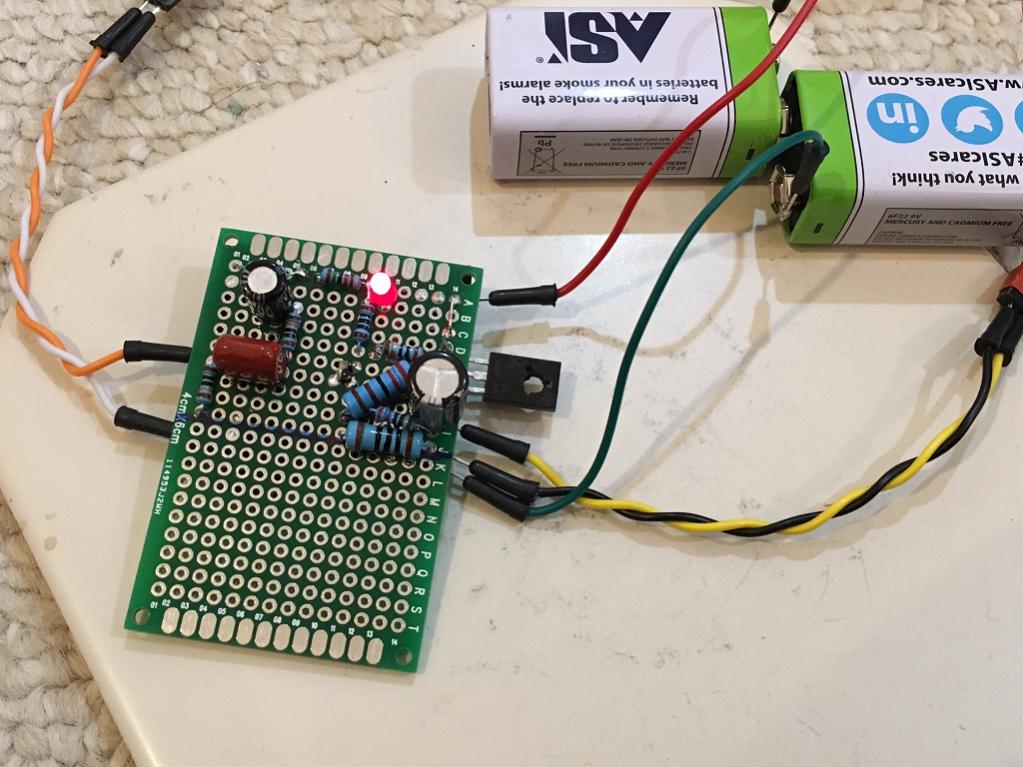
Edit: I found a mistake, I had a 2.2k instead of 220R on the collector of the BD140. Changed it out and the volume issue is still not loud enough. Hmmm...
Ok, it's late - will have to debug another day.
I have reworked the original design to maintain the jfet sonic signature, give more peak to peak output from 18V rail, drive low Z cans, and reduce the distortion across the board.
I built this some years back and it sounds stunning. It needs a BF862 with Idss selected of 10mA, and a BD140. Phase shift at 20KHz is only 0.3 degree.
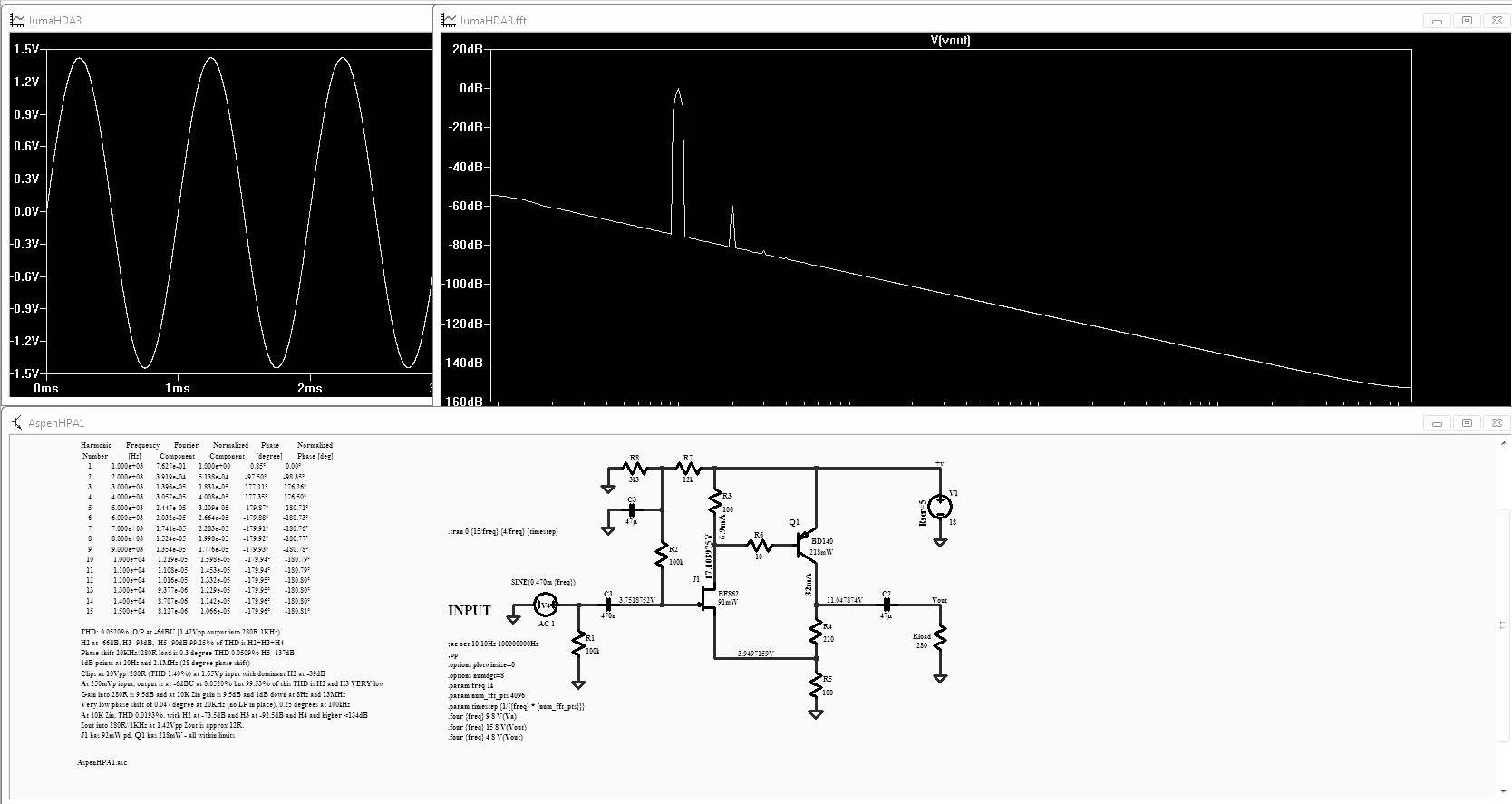
HD
I quickly threw this together on veroboard. I even left room for a second channel on a single 6cm x 8cm board. It sounds really nice and clear with impactful bass, but volume is very low (by maybe 10x) even at full volume on my DAC. So not sure what is wrong. Maybe I have an incorrect resistor somewhere off by 10x? I am using 15k instead of 12k, and 100uF instead of 47uF for C3, but that is the only one that is off spec. I am measuring 28.2mA across the 100R source resistor.

Edit: I found a mistake, I had a 2.2k instead of 220R on the collector of the BD140. Changed it out and the volume issue is still not loud enough. Hmmm...
Ok, it's late - will have to debug another day.
Attachments
Last edited:
The MOSFET follower with LU1014 triode cells, if properly built with matched devices, it'll have H2 at around -90dB level (from real measurement).... the richness of the bass reflects the additional H2 of the power amp ...
I've used these LU1014 triode cells to build a Circlotron, with everything carefully matched, the H2 is measured to be below -100dB.
Thanks CWT, perhaps the zout of the jfet triplet is way higher than the SE power amp.
X,
To improve the zout either the triplet should taken out to a quint; or use a ZXM mosfet (60V 2A 140pF) ; or move to the jfet/pnp CFP OR even replace the pnp by pmos!
Lots of choices........
HD
X,
To improve the zout either the triplet should taken out to a quint; or use a ZXM mosfet (60V 2A 140pF) ; or move to the jfet/pnp CFP OR even replace the pnp by pmos!
Lots of choices........
HD
Hugh,
Let me build a stereo pair of the triple BF862 JFET output amp before making more assessments of the sound quality. Bass impact sometimes depends on having both ears enveloped in sound. I listened to a few more test tracks and it continued to sound really good. I might have to order some ZVM4036GTA to try out. They certainly don't cost much and since no matching required, are a very economical solution.
Why is the output level of the single BJT so low? Could use of 15k where R7 is be causing too low of a bias voltage on gate of JFET? Is it a matter of not enough gain or do I need to increase bias current? When you say replace with P channel mosfet could IRF9610 work?
Let me build a stereo pair of the triple BF862 JFET output amp before making more assessments of the sound quality. Bass impact sometimes depends on having both ears enveloped in sound. I listened to a few more test tracks and it continued to sound really good. I might have to order some ZVM4036GTA to try out. They certainly don't cost much and since no matching required, are a very economical solution.
Why is the output level of the single BJT so low? Could use of 15k where R7 is be causing too low of a bias voltage on gate of JFET? Is it a matter of not enough gain or do I need to increase bias current? When you say replace with P channel mosfet could IRF9610 work?
Last edited:
Thanks CWT, perhaps the zout of the jfet triplet is way higher than the SE power amp.
X,
To improve the zout either the triplet should taken out to a quint; or use a ZXM mosfet (60V 2A 140pF) ; or move to the jfet/pnp CFP OR even replace the pnp by pmos!
Lots of choices........
HD
Are you suggesting ZXMN6A11G? Good for 4.4amps.
let us finalize a design quickly, i cant wait to make a damn layout (hopefully sponsored)😀😀. no charity this time, (see the star below my avatar, you are advised to hover your mouse pointer on that star)...
Last edited:
🙂🙂🙂🙂let us finalize a design quickly, i cant wait to make a damn layout (hopefully sponsored)😀😀
let us finalize a design quickly, i cant wait to make a damn layout (hopefully sponsored)😀😀
I am playing with the multiple BF862 JFET outputs now and like it and all, but think that probably for purposes of general consumption on DIYA, most people are not going to buy 50 to 100 JFETs and match them. I will order some small SOT223 and SOT89 N-channel MOSFETs and experiment with high current single output devices next. Will need Aksa's help to design circuit though. It will then become a 2 transistor headamp - which is kind of cool.
Here is a list of the MOSFETs I am ordering to test. These are all standard stock from Digikey.
- ZVN4306GTA (20v, 2.1A, 350pF, 330mOhm Rdson)
- ZXMN6A11ZTA (60v, 2.7A, 330pF, 120mOhm Rdson)
- BSP129H6327XTSA1 (240v, 350mA, 108pF, 6ohm Rdson)
I am sort of leaning to ZXMN6A11ZTA though. Have a look at the spec sheet:
http://www.diodes.com/_files/datasheets/ZVN4306G.pdf
Last edited:
All the best for your experimentation, I am sure Hugh (my GURUJI) will help and solve all equations for ethereal HA experience. Lets rock this HA🙂.I am playing with the multiple BF862 JFET outputs now and like it and all, but think that probably for purposes of general consumption on DIYA, most people are not going to buy 50 to 100 JFETs and match them. I will order some small SOT223 and SOT89 N-channel MOSFETs and experiment with high current single output devices next. Will need Aksa's help to design circuit though. It will then become a 2 transistor headamp - which is kind of cool.
Here is a list of the MOSFETs I am ordering to test. These are all standard stock from Digikey.
- ZVN4306GTA (20v, 2.1A, 350pF, 330mOhm Rdson)
- ZXMN6A11ZTA (60v, 2.7A, 330pF, 120mOhm Rdson)
- BSP129H6327XTSA1 (240v, 350mA, 108pF, 6ohm Rdson)
reg
Prasi
Last edited:
Playing with LTSpice
Still learning LTSpice and tried to model Juma BF862 preamp and EUVL source follower power amp (with J511 replaced with J310 CCS and zener-LED combo) together as system. Implementing Aksa's recommended change of R4 from 220k to 50k significantly reduced predicted HD.
Schematic:
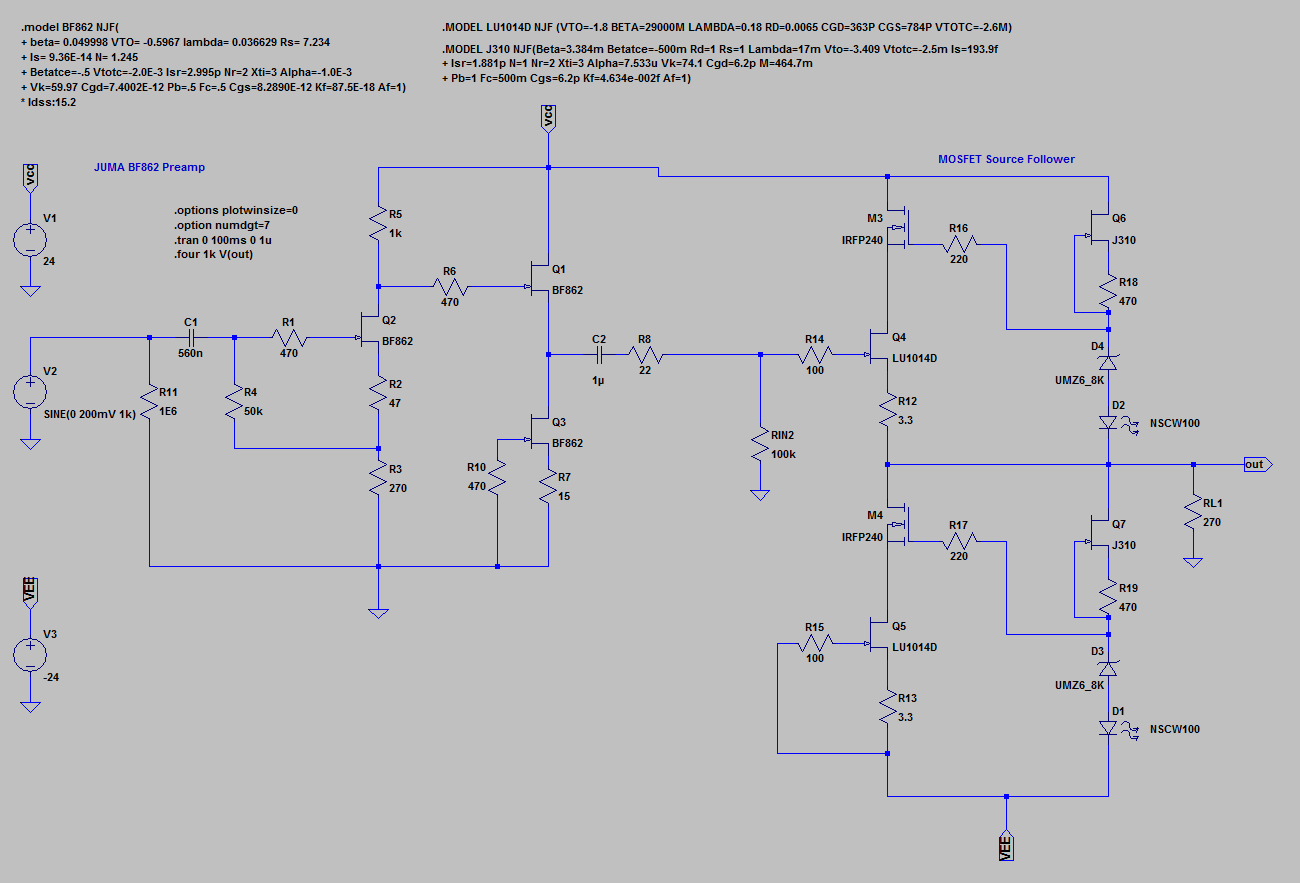
Sine of 1kHz:
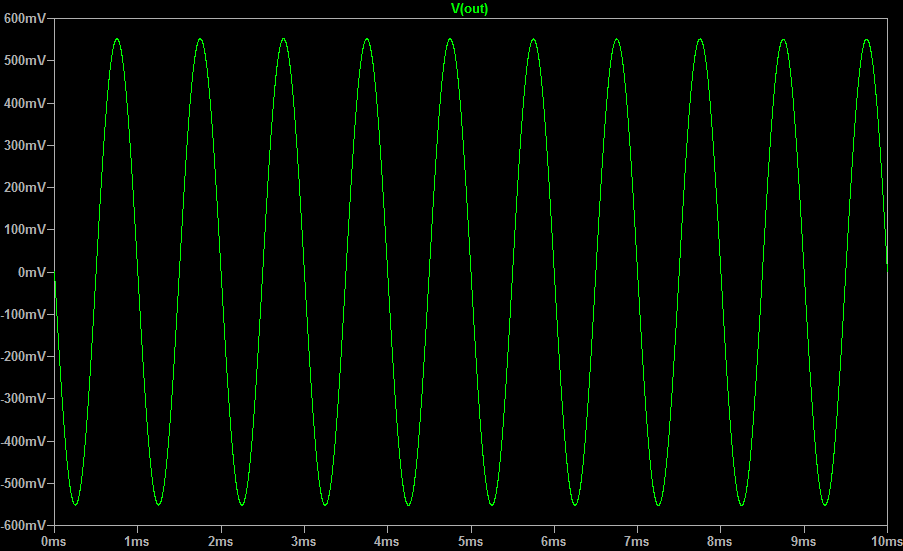
FFT (as predicted shows predominant H2 and very low H3 for great sonic signature:
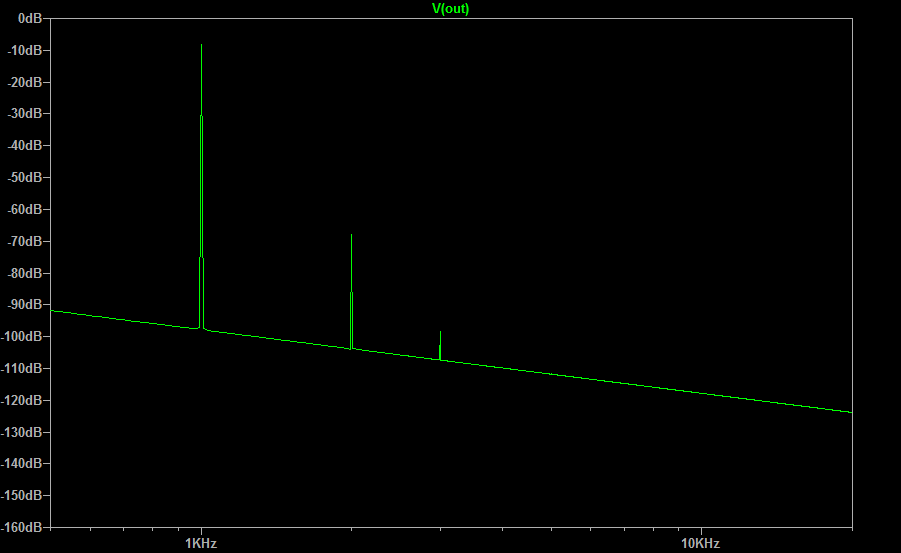
Still learning LTSpice and tried to model Juma BF862 preamp and EUVL source follower power amp (with J511 replaced with J310 CCS and zener-LED combo) together as system. Implementing Aksa's recommended change of R4 from 220k to 50k significantly reduced predicted HD.
Schematic:

Sine of 1kHz:

FFT (as predicted shows predominant H2 and very low H3 for great sonic signature:

Attachments
Last edited:
Very nice work X,
I like the predominant H2 and very low H3. Now we need to get Prasi involved...lol
Do you get the same sonic signature with a 60 ohm load ?
Thanks,
Eric
I like the predominant H2 and very low H3. Now we need to get Prasi involved...lol
Do you get the same sonic signature with a 60 ohm load ?
Thanks,
Eric
Very nice work X,
I like the predominant H2 and very low H3. Now we need to get Prasi involved...lol
Do you get the same sonic signature with a 60 ohm load ?
Thanks,
Eric
Here is sim for 60ohm load - still excellent.
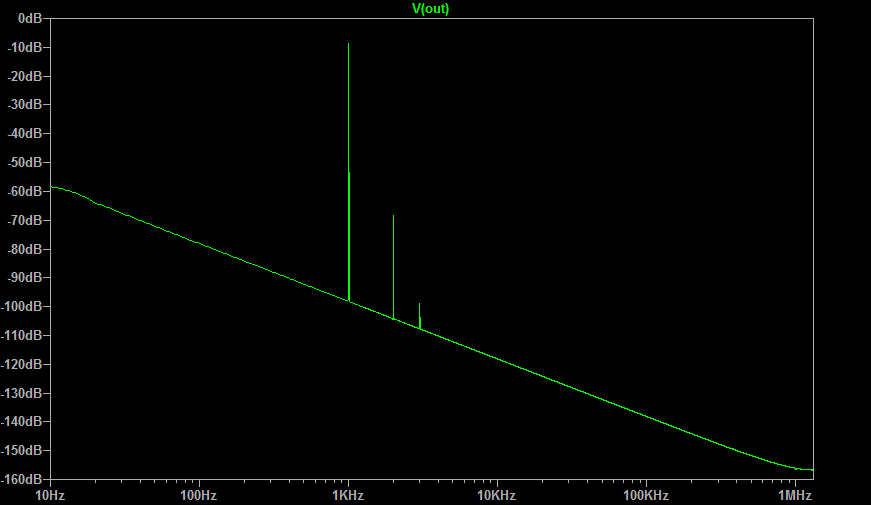
Attachments
X,
I have been studying the datasheet of the LU1014D.
Up to 69W, 100A surge, 850pF Coss, around -1 Vgs for 50mA, and good linearity to the 24V limit.
I do not understand why the output stage needs IRFP240 to cascode it.
You could use the LU1014D using as a source follower, direct connected.
They seems pretty cheap and robust; what about that idea?
Hugh
I have been studying the datasheet of the LU1014D.
Up to 69W, 100A surge, 850pF Coss, around -1 Vgs for 50mA, and good linearity to the 24V limit.
I do not understand why the output stage needs IRFP240 to cascode it.
You could use the LU1014D using as a source follower, direct connected.
They seems pretty cheap and robust; what about that idea?
Hugh
I think it is not used for cascode but more to provide CSS. I see your general approach of simplifying things by removing any uneneeded complexity. Would I just replace IRFP with an equivalent 10w power resistor? Incidentally, an IRFP is cheaper than a good 10w power resistor! 🙂
Details are explained in this article:I do not understand why the output stage needs IRFP240 to cascode it.
https://www.passdiy.com/project/amplifiers/zen-variations-8
The original idea was from Nelson Pass, later on EUVL adapted the parameters for headamp use.
Thank you, I see now he was using 50V. With a <24V supply the cascode could be dispensed with.
The LU1014D used as a source follower would have current set by the source resistor. Over a substantial voltage output the linearity would still be very good. It would NOT be very good over a full range from ground to Vcc like a power amplifier, in which the arrangement ensures constant current. It is nice to reduce the THD with CCS operation, BUT, in a HPA the output voltage is rarely more than two or three volts PP.
Hugh
The LU1014D used as a source follower would have current set by the source resistor. Over a substantial voltage output the linearity would still be very good. It would NOT be very good over a full range from ground to Vcc like a power amplifier, in which the arrangement ensures constant current. It is nice to reduce the THD with CCS operation, BUT, in a HPA the output voltage is rarely more than two or three volts PP.
Hugh
Last edited:
Juma-Aksa BF862 Amp in Stereo
I just built the second channel from start (etch PCB) to finish in record time of 90 minutes. I am using my last set of matched BF862's for this amp.
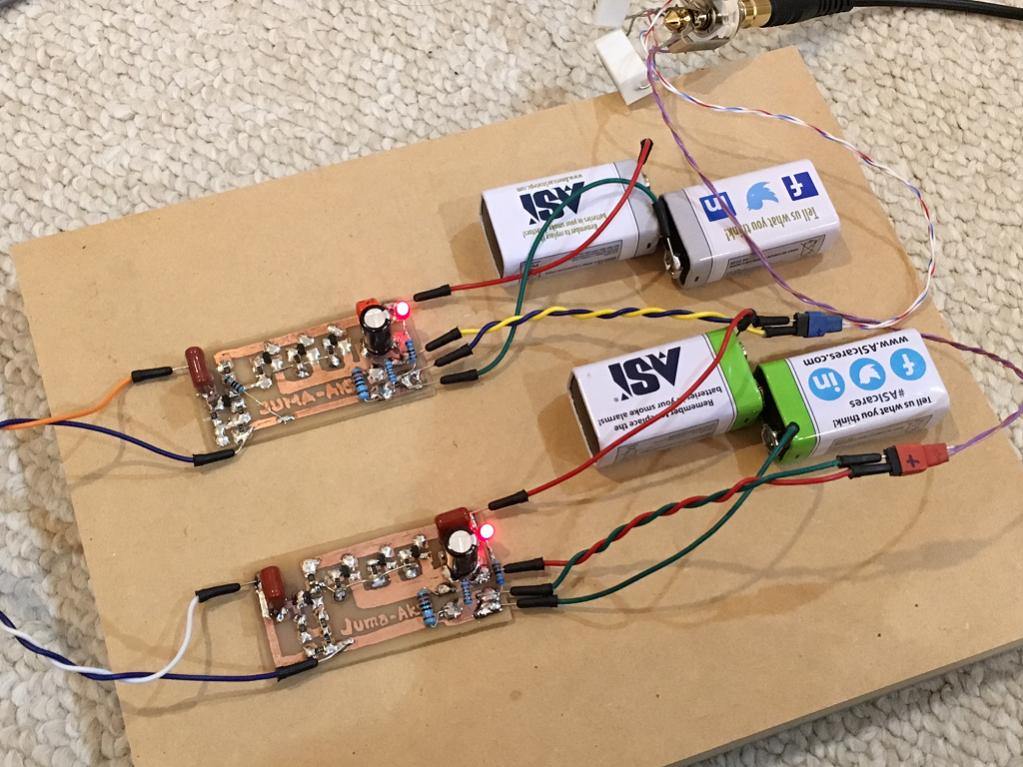
Listening to it now. Vocals test track with mids and highs are extremely clear and transparent. Very nice. Test track with bass is very good but not as powerful as my big LU1014D amp - but that amp is like the penultimate bass monster. Very nice still. Amazingly simple and effective amp and runs off a pair of 9v batteries. A set of 600mA Li-ion should last about 6hrs (total draw of about 90mA for both). I really think people will enjoy listening to this headamp.
It makes a big difference to have it in stereo to truly experience the bass and the soundstage. Amp is silent when no music playing. Of course with batteries there is no hum. 🙂
I can highly recommend this amp.
Edit: after listening to some Deep House mix tracks, the bass is surprisingly deep and powerful. Very full and rich - not weak in the least. Just making sure people don't get me wrong when I compare it to the big amp. It still shakes your head with the pounding beats on dance tracks. 😀
I just built the second channel from start (etch PCB) to finish in record time of 90 minutes. I am using my last set of matched BF862's for this amp.

Listening to it now. Vocals test track with mids and highs are extremely clear and transparent. Very nice. Test track with bass is very good but not as powerful as my big LU1014D amp - but that amp is like the penultimate bass monster. Very nice still. Amazingly simple and effective amp and runs off a pair of 9v batteries. A set of 600mA Li-ion should last about 6hrs (total draw of about 90mA for both). I really think people will enjoy listening to this headamp.
It makes a big difference to have it in stereo to truly experience the bass and the soundstage. Amp is silent when no music playing. Of course with batteries there is no hum. 🙂
I can highly recommend this amp.
Edit: after listening to some Deep House mix tracks, the bass is surprisingly deep and powerful. Very full and rich - not weak in the least. Just making sure people don't get me wrong when I compare it to the big amp. It still shakes your head with the pounding beats on dance tracks. 😀
Attachments
Last edited:
- Home
- Amplifiers
- Headphone Systems
- MOSFET Source Follower Headamp
